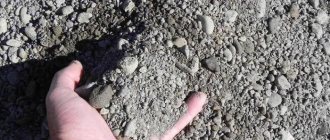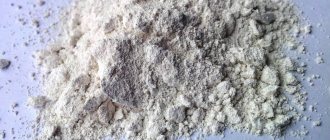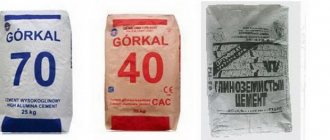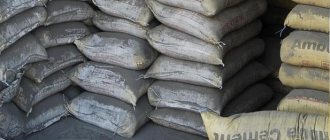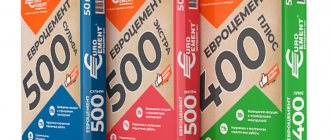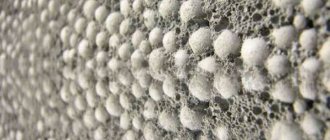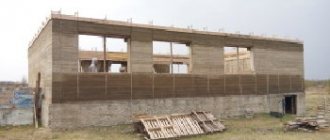Prices for prestressing cement NC
Brand
| Bag weight | Price | Payment | Stock | |
| NTs-10 - non-shrinkable | 25 kg | 370 rub. | b.cash | m. Ryazansky Prospekt |
| NTs-10 - non-shrinkable | 40 kg | 540 rub. | b.cash | Podolsk |
| NTs-20 - straining | 20 kg | 250 rub. | cash/bank cash | Chelyuskintsev village |
| NTs-20 - straining | 25 kg | 370 rub. | b.cash | m. Ryazansky Prospekt |
| NTs-20 - straining | 40 kg | 540 rub. | b.cash | Podolsk |
| NTs-40 - expanding | 25 kg | 370 rub. | b.cash | m. Ryazansky Prospekt |
| NTs-40 - expanding | 40 kg | 540 rub. | b.cash | Podolsk |
Tensile concrete on NC tensile cement exerts pressure on obstacles that limit its expansion. The force developed by a mortar or hydraulic concrete while limiting its expansion is a self-stressing force. The self-stress of the prestressing cement is measured 28 days after production. NC cement consists of 65-75% Portland cement, 13-20% aluminous cement and 6-10% gypsum. Hydraulic cements NTs are divided into stress-free cements NTs-10, cements with low self-stress energy NTs-20, cements with medium self-stress energy NTs-40, cements with high self-stress energy NTs-60.
The beginning of setting of NC tensile cements occurs 30 minutes after mixing with water, and the end of setting occurs no later than 4 hours after mixing. The use of cement additives in NC in the form of SDB, boric acid, tartaric acid, dextrin makes it possible to slow down the setting of hydraulic concrete. The hydration products of tensile cements are low-basic calcium hydrosilicates, calcium hydroaluminate, and ettringite. Aluminous slags and monoaluminate compositions can be used as an aluminate component of NC cements.
During the expansion process, NC prestressing cements create prestress in the reinforcement of reinforced concrete structures. This effect, which characterizes NC hydrocement, is used to create prestressed reinforced concrete structures without the use of mechanical or thermal methods for tensioning reinforcement. In each prestressed element of a reinforced concrete structure, elastic expansion of the cement stone of the prestressed hydraulic concrete occurs due to the resistance exerted by the reinforcement. The magnitude of this expansion is about 0.5%. In this case, the prestressed reinforcement may experience multiaxial stress.
A prerequisite for obtaining high-quality NC tensile cement that provides waterproofing is maintaining a constant chemical and mineralogical composition of the initial raw materials and strict adherence to the production technology of hydraulic cements. The use of NC prestressing cements ensures waterproofing of reinforced concrete structures and increases their crack resistance. NTs10, NTs20, NTs40, NTs60 cements are effective for the preparation of waterproofing mixtures, prestressed hydraulic concrete and sand concrete for the construction of underground and underwater structures, tanks, pipelines; It is also advisable to use NC prestressing cements during road works, at airfields, for prestressing large structures, in prestressed joints of structural elements, joints of structures under liquid and gas pressure. NC hydraulic cement can also be effective for repairing and strengthening structures. Prestressing cements provide gas-tightness of hydraulic concrete and resistance to chemically aggressive environments.
Cement waterproofing is a worthy alternative to bitumen
Even the ancient Romans modified lime by adding crushed pozzolans (volcanic ash from the slopes of Vesuvius). Masonry mortar prepared with such lime became stronger and absorbed much less water. It took people a couple of thousand years to finally, in 1844, accurately identify the components and invent the correct technology for producing a durable composition (a binder in construction terminology), called cement. Caementum is what the Romans called crushed stone. Since the beginning of industrial production, cement has been widely used as a waterproofing material. In Soviet times, for horizontal waterproofing of foundations and walls, a cement-sand mortar was used, mixed in a 1:2 ratio and applied in a small layer to a concrete pad. The so-called “ironization” is the result of rubbing fresh concrete or mortar with pure cement, giving it high strength and repelling water.
Video manual on the use of cement coating waterproofing ↑
Pure cement is used as additional waterproofing for cast iron sewer pipes. Special waterproofing concretes have been developed, which are used in the construction of hydraulic structures, subways, and swimming pools. However, for a long time it was not possible to create a cement composition based only on mineral fillers that would be easily applied to the surface and guaranteed not to allow moisture to pass through. Success was achieved in the last third of the twentieth century, when European and American chemist-technologists began experimenting with polymer materials. Modern cement waterproofing is a reliable and durable material that is not inferior, and in some respects superior, to bituminous materials. At the same time, it is inexpensive and easy to use.
Composition and main characteristics of the material ↑
The mixtures contain three components:
- Binder (astringent) is a high-quality cement that ensures the strength of the composition and largely repels water.
- The filler is fine quartz sand.
- Polymer additives. They provide increased adhesion of the composition to the base, penetrating deep into the surface of concrete and crystallizing in its structure, firmly connecting the base with the applied coating. Increases the hydrophobic properties of the cement composition. Gives elasticity to the waterproofing coating.
Cement waterproofing is much easier to work with than concrete
Properties:
- The adhesion (adhesion strength to the surface) of cement (mineral) waterproofing is higher than that of bitumen and bitumen-polymer. The compositions adhere perfectly to concrete, brick (including sand-lime brick), metal and wooden surfaces.
- Mineral insulation has high mechanical strength and is resistant to abrasion.
- Cement-polymer waterproofing has a unique property: it is vapor permeable. That is, water will not penetrate inside the structure, for example, the base of a building, while the masonry, if it is moistened, will dry out. The occurrence of delamination is eliminated if moisture does not come from outside, but from inside the concrete; it will gradually be removed outside. In such cases, moisture tears off the bitumen waterproofing. If it is “leaky” in one place, the process of detachment from the surface continues further. This does not happen with cement mixtures.
- Due to its high vapor permeability, mineral insulation can be used not only for external, but also for internal waterproofing. This is the only possible solution when reconstructing buildings.
- Cement-based waterproofing can be applied to damp surfaces.
There is no need to subject the foundation to prolonged drying and wait for weeks for dry weather. Special cement compositions (hydraulic seals) can be applied even in conditions of constant presence and leakage of water. Long-term drying of foundations is not required before treatment - Mineral compositions are environmentally friendly, harmless to humans and are recommended, among other things, for treating drinking water reservoirs and swimming pools.
- The surface treated with cement waterproofing can be finished two weeks after applying the composition without any additional preparation. Glue tiles, plaster, putty, paint - finishing materials adhere perfectly to mineral bases. Bituminous insulation will have to be covered with plaster over a mesh or screed. This is a huge plus in the manufacture of pool bowls and more.
- Cement mixtures are more durable than other known types of waterproofing. The service life is comparable to the lifespan of the building itself. Almost no repairs will be required.
- Cement waterproofing can be applied to surfaces of the most complex shapes, in contrast to adhesive waterproofing. It doesn’t matter if the wall is uneven and has rough edges. The same mixture can be used to remove small sinks, seal large ones with a solution and not wait for it to dry completely.
- Mineral-polymer insulation is very convenient to work with: it is easy and quick to apply, using the simplest tools: a spatula and a brush.
- Cement waterproofing is significantly cheaper than traditional bitumen. True, this is only true for non-deformable surfaces.
After two weeks, the pool bowl can be tiled directly along the waterproofing
The main and, perhaps, the only drawback of cement-polymer based waterproofing is its rigidity. With high strength, it is inelastic (with some exceptions). Thus, if a crack occurs in a structure, for example, a pool bowl or foundation, the waterproofing layer will also be damaged. Pasted bitumen insulation can withstand much higher tensile loads. However, modern technologies offer a solution to this problem. Two-component cement-based mixtures with a high content of polymer components are produced. If necessary, the compositions are applied in several layers, reinforced with fiberglass mesh. Internal corners are treated with special elastic rubber-polymer tapes. The result is excellent; special cement compositions are ahead of bitumen ones. Unfortunately, not only in terms of characteristics, but also in price.
Varieties of cement-based moisture-proofing compounds ↑
Based on their intended purpose, mixtures are divided into several types:
- Coating insulation is a standard and inexpensive mixture for protecting non-deformable surfaces from moisture.
Widely used: protection from moisture of foundations and plinths of buildings, both external and internal. Waterproofing of floors, swimming pools and water tanks. Treatment of slabs of balconies and exploited terraces. Apply to concrete, cement screeds, brick, plasterboard, other mineral surfaces, metal, wood. Coating waterproofing is sometimes called plaster, which is incorrect. It is convenient to apply the mixture with a spatula. You will also need a brush to handle the corners. - Elastic coating insulation is a very durable, elastic and not at all cheap composition. It is used for the same surfaces as conventional mixtures, but in cases where there is a possibility of cracks. Often these are concrete bowls of swimming pools, insulation in wooden houses. They are much superior to conventional ones in terms of abrasion and surface strength.
- Penetrating mixtures. A type of coating, they contain a larger number of polymers that penetrate deeply and crystallize in the base. Moreover, the waterproofing continues to penetrate deeper under the influence of moisture for many years and the strength of its adhesion to the base only increases over time. Any cement-polymer waterproofing mixtures have penetrating properties, and not all manufacturers classify penetrating mixtures as a separate group: a high-quality mixture has a significant amount of modifying additives and is a priori penetrating.
- Repair compounds.
Designed for waterproofing joints and cracks in concrete. For example, in a prefabricated foundation it is recommended to caulk the seams between concrete blocks with just such compounds. When reconstructing buildings, weakly sealed seams are knocked out to a depth of several centimeters, the cracks are expanded and filled with a mixture. Some manufacturers provide the use of coating compounds to repair cracks. Seams and cracks must be caulked tightly. You should have several narrow spatulas on hand - Hydro seals (plugs). Compositions similar to the previous ones, but much more effective (and expensive). Active cracks and seams are sealed, even if water seeps through them during work. They set very quickly. There are even special cement compositions that can be used directly under water; they are used to eliminate leaks in shipbuilding.
Waterproofing technology ↑
First, you need to carefully study the manufacturer's instructions. For complex cases, which include restoration of waterproofing in existing buildings, restoration of structures, insulation of a swimming pool, processing of potentially deformable building structures, detailed technological maps have been developed, which specify the sequence of actions and the necessary materials. As a rule, this information can be found on manufacturers' websites or from dealers.
Before starting work, surfaces must be cleaned of dust, dirt and oils.
In some cases, manufacturers recommend pre-treatment of the surface with a special strengthening-penetrating primer. Often the surface needs to be moistened immediately before starting work.
The crumbling mortar and concrete are removed from the seams and cracks, cleaned and tightly caulked with a repair compound.
Cracks and seams are opened and tightly filled with a repair insulating compound or seal. They can also be used to seal large sinks.
Coating compounds are applied with a brush or spatula, but not with a roller, as is sometimes done. There are industrial installations for applying the mixture under pressure. The cement mixture is thoroughly rubbed or smeared into the surface, leaving no gaps. Small shells are filled with the mixture. To achieve the desired result, apply two or three layers. It is more convenient to work with a brush, but a spatula allows you to achieve better results.
The interior treatment of the precast concrete basement walls has been completed. After two weeks the surface can be finished; plastering is not required
Cement-based waterproofing is a worthy alternative to bitumen, effective and in most cases more economical. When carrying out internal waterproofing of basements and basement floors, this is generally the only option. Types of work where roll bitumen waterproofing cannot yet be fully replaced by cement - insulation of roofs and construction of underground structures in moisture-saturated soils. The technology for performing the work is extremely simple and requires only precision. In Russia, high-quality waterproofing mixtures of the German brands “Ceresit”, “Remmers”, “Bergauf”, domestic “Hydrotex”, “Penetron” are well known, the list is far from complete. When purchasing dry mixtures, you need to pay attention to their shelf life, it is limited.
hydroguide.ru
Alunite Tensile Cement
To obtain alunite cement, alunite is fired to form sodium, potassium and aluminum sulfates, alum, and alumina. The resulting components of prestressed cements actively enter into chemical reactions with the hydration products of cement clinker. The equilibrium of phases in alunite depends on the temperature and duration of firing to which the prestressed hydraulic cement is subjected. Depending on the activity of the calcined alunite rock and the amount of aluminum and sulfuric anhydride ions in the prestressing cement, which passed into the liquid phase during the hydration of cement in hydraulic concrete, different types of cements are formed: non-shrinking, expanding and prestressing. The content of tricalcium aluminate in the original Portland cement clinker is at least 7%, and alunite - at least 50%. Klein's tensile cement is produced by grinding a mixture of Portland cement clinker, gypsum and sulfoaluminate clinker, which is the expanding component.
Waterproofing mixtures, sand concrete and prestressed hydraulic concrete based on prestressing cements
When using NC prestressing cements, it is necessary to observe a number of special measures to ensure that waterproofing mixtures, sand concrete, mortars and prestressing hydraulic concretes based on NC cement are obtained of the best quality. To obtain waterproofing sand concrete and a waterproofing mixture, it is necessary to mix NC cement with washed sand in a ratio of 1:2. To obtain a solution, you need to mix the cement-sand mixture with water in an amount of 40% by weight. It is not allowed to work with NC tensile cement under water pressure. The solution must be applied by torquetting or pneumatic spraying. Applying the solution manually is allowed only if the necessary compaction of the waterproofing mixture is ensured.
To prepare prestressed hydraulic concrete based on NC prestressing cements, it is necessary to thoroughly mix the hydraulic cement in the waterproofing concrete mixture, and thoroughly compact it when laying the concrete. The next day after pouring prestressed hydraulic concrete, it is necessary to moisten the surface of the concrete structure and then maintain the surface moisture for seven days. To avoid loss of special properties of tensile cement, it is unacceptable to mix NC tensile cement with other types of cement.
Application of NC tensile cement for concreting swimming pools
Tensile cement NTs-10, NTs-20, NTs-40 and NTs-60 are widely used for concreting swimming pools to form a prestressed reinforced concrete pool structure that has a high density without any cracks or voids. Before pouring the bottom of the pool with prestressed hydraulic concrete prepared using NC tensile cements, the inlet and outlet water pipes are adjusted and all embedded elements are tied with rubber or a special hydrophilic profile, which makes it possible to waterproof the gaps between the embedded elements and the hydraulic concrete that forms the pool bowl.
When pouring a pool with prestressed hydraulic concrete, increased attention is required to the joints between the planes of the pool bowl, in particular, the bottom and sides of the pool. Due to its expansion and tensile properties, hydraulic concrete based on NC tensile cements can distort the geometry of surfaces with a changing plane. If NC hydraulic cement is used to gradually fill the pool bowl, before the next stage of pouring with prestressed hydroconcrete, a hydrophilic rubber profile is installed on the cold seams to ensure waterproofing of the seam. The rubber profile is secured using glue or fasteners.
If an old pool is being repaired, then before pouring prestressed hydraulic concrete using NC prestressing cement onto the old concrete, it is necessary to treat the joints with latex material, which increases adhesion between the old and new prestressed concrete. New prestressed hydraulic concrete must be poured immediately after the joints have been processed, with a period of full completion of at least six months after pouring.
It is also advisable to make expansion or expansion joints in a bowl made of prestressed hydraulic concrete. The need for moving joints depends on the type of foundation under the pool, the brand of tensile cement used (NTs-10 or NTs-20, NTs-40) and the design of the pool itself. It is preferable to provide movable seams if the length of the pool is more than thirty meters, but if the length of the pool exceeds fifty meters, such seams are required. Movable seams should run from the base of the prestressed hydraulic concrete to the tile layer, coinciding in projection with the tile seams.
After curing the prestressed hydraulic concrete until it is completely mature, hydrotesting of the pool is carried out by filling it with water to the upper edges of the sides. The pool is left in this condition for at least fourteen days to check the effectiveness of the waterproofing. If, despite the tensile effect of hydraulic concrete, cracks or leaks are found, they are sealed with waterproofing compounds and mixtures based on NC tensile cements. When hydrotesting a pool, the degree of subsidence of the pool bottom as a result of filling with water is also determined. After hydrotesting and draining of water, the prestressed hydraulic concrete is thoroughly dried.
Waterproofing a swimming pool using NC prestressing cement mixtures
After casting the pool bowl from prestressed hydraulic concrete, additional waterproofing of critical areas of the pool is carried out using waterproofing materials and mixtures. dry mixtures LURS are widely used , the main component of which is NC tensile cement. Before using the LURS waterproofing mixture, the surface of the hydraulic concrete is cleaned using water jet or hydraulic means, shot blasting or sandblasting equipment. At the same time, dust, crumbs, protruding surface defects, and oily substances that prevent the adhesion of the waterproofing solution to the hydraulic concrete are removed.
Irregularities in prestressed hydraulic concrete are leveled by plastering with a waterproofing solution containing fine quartz filler. For better adhesion of the waterproofing solution to the walls of the pool, a waterproofing mixture can be used that contains, in addition to NC tensile cement, synthetic latex additives. In addition, the walls of the pool can be leveled using structural plaster. The thickness of the layer of plaster applied to the walls of the pool can range from four to thirty millimeters. The applied solution must be left for seven days before further work is carried out.
The pool is waterproofed using a waterproofing solution based on tensile cement NTs-10, NTs-20 or NTs-40. Before using the hydraulic mixture, clean the surface of the hydraulic concrete so that it is clean, dry and smooth. Care should be taken to ensure that the moisture content of the prestressed concrete is no more than 3%. Vertical and horizontal corners and joints of the pool bowl, as well as embedded elements, are subject to waterproofing with prestressing compounds. To insulate such interfaces as side-bottom and side-side, waterproofing tape is used.
The embedded elements used in the construction of the pool are additionally insulated with elastic patches by gluing them between layers of waterproofing. Waterproofing layers can be reinforced with fiberglass mesh. The total thickness of the waterproofing layers must be at least 4 mm. The applied NC hydraulic mixture is kept for at least five days.
Scope of application
The material can be used in a number of cases:
- ensuring waterproofing of objects that are constantly exposed to moisture, including basements, ground floors, etc.;
- protection of surfaces that are simultaneously exposed to intense mechanical loads and water, for example, swimming pools;
- construction of facilities subject to extreme pressure: runways, floors of industrial premises;
- restoration of the properties of old structures, repair of seams and joints of concrete slabs;
- construction of bridges;
- roof installation when monolithic concrete elements are used.
Where to buy NC tensile cement at a factory price
Our company produces and wholesales high-quality tensile cement of the NTs10 and NTs20 RUSEAN brands, prestressed sand concrete and waterproofing prestressing mixtures LURS based on non-shrinking and expanding cements. We sell prestressing cement NC RUSEAN wholesale from the factory and from warehouses in Moscow in bulk and in bags by cars and wagons. Pickup by rail is also possible.
You can buy NC prestressing cement from us for the construction of swimming pools, saunas, critical industrial facilities and hydraulic structures that come into contact with the aquatic environment and require high-quality waterproofing. From us you can always buy high-quality prestressing cement NTs-10 and NTs-20, dry non-shrink mixtures and prestressed sand concrete LURS wholesale at factory prices on favorable terms for you with delivery to construction sites.
Kinds
The following types of cement are distinguished:
- NC - tense;
- GC - aluminous;
- ROC—expanding Portland cement;
- WRC is a waterproof expanding cement.
Each option differs in composition. The difference in properties is noted between mixtures that contain the same active substances, but in different dosages. As a result, the level of hardness, speed of setting and strength gain, and moisture resistance change. You cannot mix different types and brands of compounds.
It is a mistake to believe that in this case the hardness of the finished structure will increase. On the contrary, if different materials are mixed, hardening will occur unevenly. This will result in poor performance.
